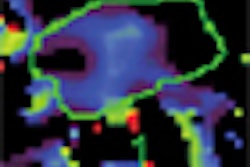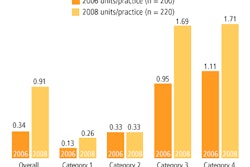Patients diagnosed with acute appendicitis at CT sometimes recover enough to skip the surgery and go home. But the miraculous recovery rarely lasts, and most patients end up returning for the appendectomy they'd hoped to avoid, say researchers from the University of California, San Francisco (UCSF).
Dr. Joseph Stengel and his team were intrigued by reports of patients who told the surgeon or the emergency department physician they were feeling fine, really, despite a positive diagnosis of acute appendicitis at CT.
To be sure, there are times when the benign clinical picture simply doesn't match the CT results, Stengel told attendees of the 2008 RSNA meeting in Chicago.
"Either [the abdomen] wasn't tender or they didn't have leukocytosis or they had what the surgeons called the 'Ronald McDonald sign,' or the 'powdered donut sign,' or the 'Krispy Kreme sign,' depending on where you are," Stengel said. "They'd go down to see the patient, [who] would be sitting up in bed eating a number one with a Coke and fries."
Two cases of apparent recovery had even gone through the facility's peer review to determine if the CT diagnoses had been correct -- they had been. Hence the study, which aimed to investigate clinical outcomes in patients who had a positive diagnosis of appendicitis at CT, but whose treatment was at first deemed unnecessary after initial interpretation.
The medical literature has reported a false-positive (negative appendectomy) rate of about 2% to 5% after a positive CT, Stengel said; for patients who go directly to surgery without imaging, the incidence of false positives can be as high as 15% to 20%.
"Most studies are based on the gold standard of gross pathology, but we wanted to augment this gold standard with clinical outcomes in patients," he explained. "Our goal was to identify patients who don't go to surgery despite the [positive] findings at CT."
Stengel, along with Dr. Emily Webb, Dr. Liina Poder, Dr. Benjamin Yeh, and colleagues, retrospectively reviewed the records and CT images of 2,283 adults who underwent abdominal CT for suspected appendicitis between 2002 and 2007.
Over the five-year study period, multiple CT scanners were used including 4-, 16-, and 64-detector-row machines (GE Healthcare, Chalfont St. Giles, U.K.), "generally using 3-mm axial and coronal reconstructions; the 64-[detector-row scanner] spits out sagittal and coronal reconstructions automatically," Stengel said.
The CT reports were classified by likelihood of acute appendicitis (from 1, "appendix not visualized," to 5, "definite appendicitis"), and all available medical records were reviewed to determine patient outcomes.
Patients diagnosed with probable or definite acute appendicitis at CT (scores 4 or 5) who were not treated with surgery, antibiotics, or percutaneous drainage within three days of imaging were deemed apparent false positives. In this way "we teased out the cases that were handled nonoperatively," Stengel said.
Overall, 499 patients (22%) had CT findings that were considered probably or definitely appendicitis. Of these, 50 of the cases (10%) were treated nonoperatively, including 30 patients who were given antibiotics intravenously and 20 who underwent percutaneous drainage. A total of 14 patients (3%) -- four men and 10 women, with a mean age of 44 years -- were not treated; however, six of the 14 (43%) subsequently returned to undergo appendectomy for acute appendicitis at a mean interval of 61 days post-CT (range, 6-120 days), Stengel said.
"To put that in perspective, 43% of the patients with recurrent appendicitis compares to a 0.25% annual incidence and a 9% lifetime incidence in the literature," Stengel said. "Clearly these people were at orders of magnitude greater risk of appendicitis."
And while the literature shows perforation occurring in about 10% of cases, the UCSF series found that four of the six patients (29%) who returned had a perforated appendix -- about three times the rate in the literature, he said.
Patients were referred to a gastroenterologist for follow-up at discharge. None of the remaining eight patients developed appendicitis over a mean follow-up interval of 583 days (range, 14-1,460 days).
Of these eight patients, two were eventually given a diagnosis of gastroenteritis, and there were six patients whose symptoms simply abated.
Overall, CT had a sensitivity of 97%, specificity of 99%, and positive predictive value of 95% for the diagnosis of appendicitis. Eighteen patients had an alternative diagnosis, and only five were completely negative, Stengel said. These cases are being reviewed for additional clues.
"We are in the process of reviewing the cases for features which might identify these self-limited cases, but in general they look no different than the pathologically proven appendectomies," Stengel told AuntMinnie.com in an e-mail.
Alternative diagnoses ran the gamut from mucocele to ischemic appendix, ischemic cecum, mucinous adenocarcinoma, and Kaposi's sarcoma, he said.
"A substantial portion of CT diagnoses of acute appendix in which immediate treatment is deferred ultimately returns with acute appendicitis," Stengel concluded. "The decision to forego surgery in patients with CT findings amenable to appendicitis or a reassuring surgical evaluation often results in missed appendicitis."
By Eric Barnes
AuntMinnie.com staff writer
January 12, 2009
Related Reading
CT coronal reconstructions aid pediatric appendicitis diagnosis, January 12, 2009
CT important in emergency diagnosis of appendicitis, October 31, 2008
Sonography should be first imaging study for suspected appendicitis, May 23, 2008
CT use cuts false positives for appendicitis, March 19, 2008
CT scans lower risk of unnecessary appendix surgery, February 29, 2008
Copyright © 2009 AuntMinnie.com



















